Some commentators are comparing the federal government’s use of emergency legislation to deal with the prolonged “freedom convoy” protests in Ottawa and the Ontario government’s decision, since abandoned, to invoke the notwithstanding clause to impose back-to-work legislation on education workers.
Read more: Preventing use of the notwithstanding clause is a bad idea — and unnecessary
Is there any merit to the comparison?
Virtually none.
At worst, it’s based on a crude depiction of what each legal mechanism allows a government to do. Since both the Emergencies Act and the notwithstanding clause authorize governments to suspend the rights of citizens, each is equally offensive to the principles of liberal democracy. Or so the argument goes.
Motivations are critical
What this argument fails to appreciate is that the reason for the suspension in either case makes all the difference.
The Emergencies Act permits the federal government to take “special temporary measures to ensure safety and security during national emergencies.”
Written into the act is an explicit definition of what constitutes a national emergency, a declaration that the exercise of powers under the act must comply with obligations under various rights documents (including the Charter of Rights and Freedoms) and that an inquiry into the appropriateness of its use begin within 60 days of the order being lifted.
The notwithstanding clause, on the other hand — or Sec. 33 of the Charter — permits both the federal and provincial governments to enact legislation even if it violates other rights protected under the Charter.
In a word: the presence of an “emergency” distinguishes one from the other.
Emergency legislation operates in response to an emergency situation, and only for as long as an emergency situation persists.
Not so with the notwithstanding clause. Invoking the clause is not a legislative response to an emergency, but rather to a disagreement. More specifically, it’s a response to a disagreement between a legislative body and a body of judicial review.

‘Rogue judiciary’
The notwithstanding clause offers a check against the possibility of a rogue judiciary becoming overly radical in its duties, which, as I’ve written before, is in alignment with Canada’s unique constitutional history.
Read more: In defence of the notwithstanding clause: Why Canada should hold onto it
Safeguards that apply to the Emergencies Act don’t apply to the notwithstanding clause.
It would make little sense, for instance, to set up an inquiry to review whether a government was justified in violating the rights of citizens via the notwithstanding clause since the entire rationale of Sec. 33 was to grant final say in the matter to the government in question.
And it would make little sense to require use of the clause to comply with broader obligations under the Charter. That’s because its very use makes clear that a government has declared its legislative intentions are worthy of a rights violation.
So comparing the Emergencies Act to the notwithstanding clause due simply to the rights-violating potential of each is misguided.
‘Antagonistic’
Recent uses of the notwithstanding clause by the Québec government, which used it pre-emptively in two bills, and Ontario, which invoked it after passing legislation in 2021 and then invoked it pre-emptively last month, are antagonistic to our broader constitutional commitments.

The legitimacy of the notwithstanding clause is grounded in the possibility that an elected legislative body may disagree with how a court has balanced a rights violation in a given case.
Under these conditions, it could be argued that granting final say to the elected body over the unelected court is democratically appropriate.
But when a government chooses to invoke the clause pre-emptively — as appears to now be the trend — even before disagreement with a review body has had a chance to materialize, that’s no longer a democratically appropriate way to resolve a dispute. Pre-emptively invoking Sec. 33 transforms it into an authoritative mechanism to enforce legislation that violates constitutional rights.
There’s no argument that can square this manoeuvre with the principles of liberal democracy.
The point is seen clearly if we consider Sec. 1 of the Charter, the so-called “reasonable limits” clause.
In every case where a review court finds that a given piece of legislation violates a Charter right, the government in question is given an opportunity to explain why that violation represents a justifiable limit on the enjoyment of the right.
Shutting down dialogue
That opens a dialogue between the offending government and the review court on the objectives of the legislation at issue, and whether those objectives are pressing enough to justify a limitation of the violated right.
Pre-emptive use of the notwithstanding clause circumvents this vital step in the process. Far from being part of the dialogue, it shuts down dialogue altogether.
Pre-emptively invoking Sec. 33 does great damage to our constitutional heritage. Invoking the Emergencies Act in the event of an emergency does no such thing.
If the notwithstanding clause becomes little more than a tool for political expediency, any rationale for including it in the Charter in the first place is lost.
Its pre-emptive use effectively guts Canadian democracy and nullifies the Charter. The consequences could be dire.

